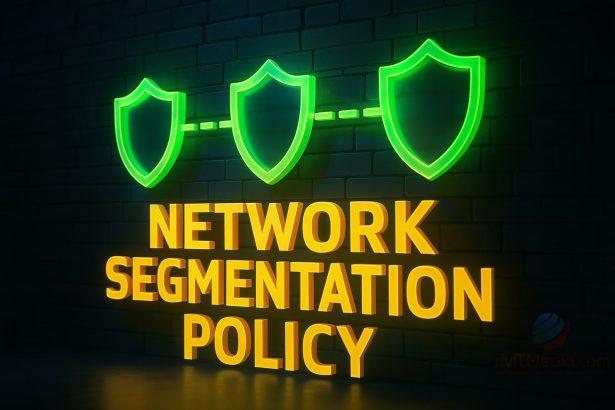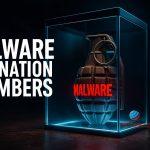Imagine a burglar enters a large office building. If every door is unlocked and every room connected, the intruder has free reign. But if critical areas are locked and separated, the damage is limited. This is the essence of network segmentation—a key cybersecurity strategy that separates parts of a company’s network to contain threats and reduce risk.
As cyber threats grow more advanced, small and medium-sized enterprises (SMEs) must adopt robust internal defenses. A network segmentation policy isn’t just for large enterprises. It’s a vital layer of protection for any business that handles sensitive data, uses cloud services, or supports remote teams.
What Is a Network Segmentation Policy?
A network segmentation policy is a formal document that outlines how a company divides its IT network into smaller, isolated segments to control traffic, reduce risk, and enforce security rules.
Key Objectives:
- Limit lateral movement of threats (e.g., malware or hackers)
- Enhance access controls by segment
- Improve performance by reducing congestion
- Support compliance with industry regulations
Why SMEs Need Network Segmentation
1. Contain Cyberattacks
When networks are flat (fully connected), attackers who breach one device can easily move through the entire system. Segmentation acts like internal firewalls, preventing this spread.
2. Protect Sensitive Data
Customer records, financial data, and intellectual property should live on separate, secure network segments—reducing the chance of widespread exposure in a breach.
3. Support Compliance Requirements
Regulations like HIPAA, PCI-DSS, and GDPR often require data isolation. Segmentation helps meet these mandates efficiently.
4. Simplify Monitoring and Management
Security teams can tailor monitoring tools to specific segments, allowing for faster detection of unusual activity.
Core Components of a Network Segmentation Policy
1. Network Architecture Overview
Document your network’s current structure, including key systems, endpoints, servers, and connections.
2. Segmentation Rules and Zones
Define zones based on function or sensitivity:
- Public Zone: Internet-facing systems
- DMZ (Demilitarized Zone): Email, web, and DNS servers
- Internal Zone: Workstations and internal servers
- Restricted Zone: Finance systems, HR data, customer databases
3. Access Controls
Set user permissions per segment. Use role-based access control (RBAC) and multi-factor authentication (MFA) for sensitive zones.
4. Traffic Control and Firewall Rules
Establish policies for what types of traffic can enter or leave each segment. Use firewalls and access control lists (ACLs) to enforce them.
5. Monitoring and Logging
Each segment should have dedicated logging and anomaly detection to quickly identify and respond to threats.
6. Policy Review and Updates
Review the segmentation policy quarterly or after major network changes.
Best Practices for Effective Network Segmentation
- Start with a Risk Assessment: Identify critical assets and areas of high risk.
- Use VLANs and Subnets: Logical separations improve control without overcomplicating the physical infrastructure.
- Implement Endpoint Protection: Use anti-malware like SpyHunter Multi-License to protect devices across segments.
- Educate Employees: Train staff on the importance of network zones and safe access habits.
- Test Regularly: Perform penetration tests to evaluate the effectiveness of segmentation.
Real-World Example: Preventing a Ransomware Spread
In 2023, a mid-sized accounting firm suffered a phishing attack. Malware entered through a user’s email client. However, thanks to their network segmentation, the threat was confined to the user zone. Client databases and financial records were untouched—saving the firm from a costly data breach.
The Role of SpyHunter in a Segmented Network
A robust endpoint protection tool like SpyHunter, with a multi-license option, helps secure all devices across your network zones—especially for remote or BYOD environments. This ensures that even if a segment is compromised, SpyHunter’s real-time threat detection limits the impact.
👉 Protect your segmented network with SpyHunter Multi-License
Conclusion: Secure from the Inside Out
Network segmentation isn’t just a technical upgrade—it’s a smart business move. By limiting access, controlling traffic, and isolating threats, segmentation fortifies your internal defenses and reduces the blast radius of any cyber incident.
Don’t wait for a breach to highlight the gaps. Implement a network segmentation policy today and pair it with comprehensive malware protection like SpyHunter.
Protect Your Business’ Cybersecurity Now!
Protect your business from evolving cyber threats with our tailored cybersecurity solutions designed for companies of all sizes. From malware and phishing to ransomware protection, our multi-license packages ensure comprehensive security across all devices, keeping your sensitive data safe and your operations running smoothly. With advanced features like real-time threat monitoring, endpoint security, and secure data encryption, you can focus on growth while we handle your digital protection. **Request a free quote today** for affordable, scalable solutions and ensure your business stays secure and compliant. Don’t wait—get protected before threats strike!




